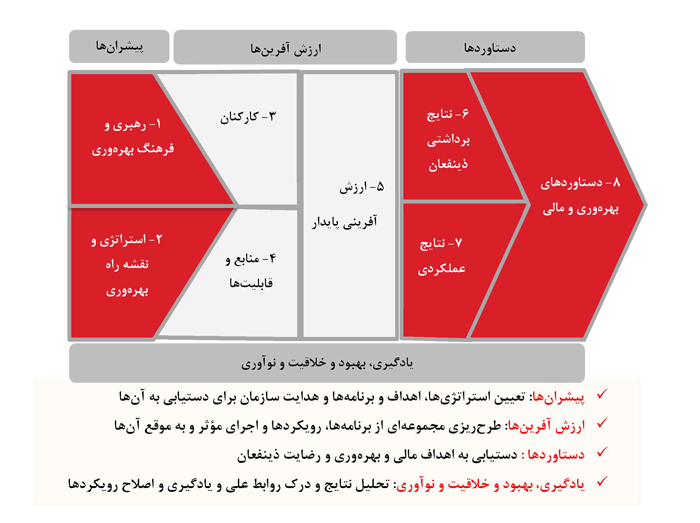IMIDRO Productivity Model
Iran Alumina Company
Productivity model IMIDRO
The Mining and Mineral Industries Productivity Model, 1402 Edition, provides a framework through which the fundamental concepts and principles of productivity can be established in organizations. The model includes main criteria, sub-criteria and guidelines that are designed in three sections: drivers, value creators and achievements. In the drivers section, leadership and strategy and the necessary prerequisites and backgrounds for designing the productivity model and roadmap are provided, in the value creators section, a set of programs, approaches, implementation of systems and application of tools to achieve the organization’s goals are provided, and in the achievements section, the impact of these measures on stakeholders and productivity is evaluated.
The criteria and sub-criteria of the model are as follows:
Propellants:
1- Leadership and productivity culture
Leaders of productive organizations develop a culture of productivity and the necessary management systems, and in this regard, support and appreciate their employees in playing a role in continuous improvement. They personally act as role models in realizing organizational values and a culture of productivity, and are committed to social responsibilities.
1-1- Leadership and culture building
2.1- Continuous improvement and transformation
3-1- Social responsibility
4-1- Organizational performance management
2 – Productivity strategy and roadmap
Leaders of productive organizations outline the guiding principles and ensure the formulation and implementation of organizational strategies based on the current and future needs of stakeholders and external and internal environmental changes. They plan and implement a unique productivity roadmap tailored to the nature of their business and strategies based on the “Principles of Total Quality Management” and the “Principles of Productivity.”
1-2- Direction-setting pillars
2.2- Strategy development and implementation
3.2- Strategy Evaluation
4.2- Developing a productivity roadmap
Value creations:
3- Employees
Productive organizations consider human resources as the most important factor in improving productivity, identify their individual and group capabilities, and improve productivity indicators by training, empowering, and engaging them. They recognize their efforts to improve productivity and provide them with a safe and healthy environment.
1.3- Planning and staffing
2-3- Employee empowerment and communication
3-3- Appreciation and rewards for employees
4.3- Employee safety and health
4- Resources and capabilities
Productive organizations provide the tangible and intangible assets needed for sustainable value creation and take steps to improve productivity.
1-4- Financial and economic management
2.4- Physical and energy asset management
3-4- Knowledge Management and Information Technology
4-4- Research and Technology Management
5- Sustainable value creation
Productive organizations identify and evaluate their suppliers in line with their strategies and ensure a sustainable supply of inputs. Productive organizations also design, produce, deliver, and support the products and services customers expect, and improve efficiency in the value chain through effective customer relationships.
1.5- Sustainable supply
2.5- Design and Optimization
3.5- Production and realization of services
4.5- Customer Management
5-5- Environmental protection
Achievements
6- Results perceived by stakeholders
1.6- Customer Perceptual Results
2.6- Employee Perception Results
3.6- Community Perceptual Results
4.6- Perceptual results of partners and suppliers
5.6- Stakeholder Perception Results
7 – Performance results
1.7- Customer performance results
2.7- Employee performance results
3.7- Community performance results
4.7- Performance results of partners and suppliers
5.7- Performance results of processes and resources
8- Productivity and financial gains
1-8- Sales and Income
2.8- Operating Profit (EPS)
3.8- Financial ratios
4.8- Total productivity
5.8- Total Factor Productivity (TFP)
6.8- Capital productivity
7-8- Raw material productivity
8-8- Energy efficiency
9-8- Machinery productivity


